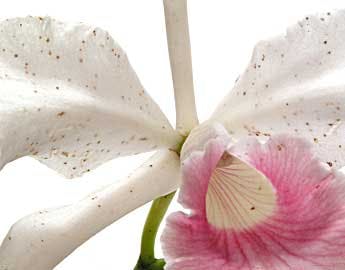
Bacteria


Gallery


Symptoms
Erwinia – Various Erwinia species cause diseases commonly known as bacterial soft rot (Erwinia carotovora), bacterial leaf rot (Erwinia chrysanthemi) and bacterial brown rot (Erwinia cypripedii). Note: the genus Erwinia genus is now known as Pectobacterium, although many orchid references still use the term Erwinia.
Symptoms - Water soaked spots may appear first on the leaves rapidly spreading to the rest of the leaf and into the pseudobulbs and roots. The advancing water soaked edge is characteristic of the disease, as is the foul odor of infected tissue. All orchids are susceptible to this bacterial rot. Symptoms on commonly affected genera include:
Phalaenopsis. The disease enters through wounds and can spread so rapidly that plants may be completely rotted in 2-3 days.
Paphiopedilum. Brown rot of paphiopedilums appears first as a chestnut brown spot on a leaf, often very near or at the rhizome, and spreads through successive leaves until the whole growth is affected. It spreads so rapidly the entire plant can be killed.
Cattleyas. The disease starts with a water soaked green spot on the leaf. The inner tissue is destroyed rapidly and the epidermis (outermost layer of leaf tissue) can easily break open spilling the watery content and contaminating the area.
Pseudomonas – Bacterial brown spot is caused by Pseudomonas cattleyae, which enters the plant through wounds or the stomata. Note: the genus Pseudomonas is now known as Acidovorax, although many orchid references still use the term Pseudomonas.
Symptoms: The symptoms may appear anywhere on the leaf as a small water soaked spot which is initially dirty green, becoming brown or black and sunken as it enlarges. All orchids are susceptible to this bacterial rot. Symptoms on commonly affected genera include:
Phalaenopsis. Bacterial brown spot is the most common and severe disease of phalaenopsis. The symptoms may appear anywhere on the leaf as a small, soft, water soaked blister. Initially dirty green in color, the infected spot enlarges, coalesces and eventually becomes brown or black, dried up and sunken. It oozes bacteria-laden liquid, particularly when the disease reaches the tip of the leaf. It is most prevalent during the warmer weather.
Cattleyas. In mature cattleyas, the disease advances slowly and is rarely fatal. However, young tender leads can develop sunken brown to black spots that can coalesce and ultimately kill the growth.Seedlings.
Seedlings of all genera: Seedlings can be killed quickly by this disease, particularly if it invades the plants through stomata rather than damaged tissue. The disease in seedlings is often called damp-off.
Treatment
Erwinia treatment: Remove the plant from the growing area. Remove and destroy all infected tissue and spray remaining portion of the plant with a bactericide. The bacteria spreads readily thorough oozing fluids so disinfect the growing area and consider spraying bactericide on surrounding plants.
Pseudomonas treatment: Sanitize the plant by removing infected tissue.
Prevention
Erwinia prevention: Good sanitation and increased air movement may help reduce the risk of infecting other plants. Avoid overhead watering and misting systems. Preventive sprays of a suitable bactericide may be applied before and after wet weather and cold spells. Avoid repotting during periods of very hot weather. Such stress weakens the plants and can make them susceptible to erwinia infection.
Pseudomonas prevention: Good sanitation and increased air movement my help reduce the risk of infecting other plants. Avoid overhead watering and misting systems. Preventive sprays of a suitable bactericide may be applied before and after wet weather and cold spells.

FREE ACCESS: Orchid DealWire
Get notified when orchid vendors have special promotions and exclusive savings.








